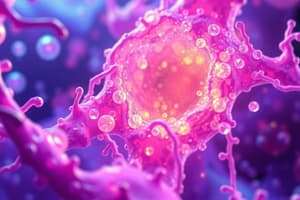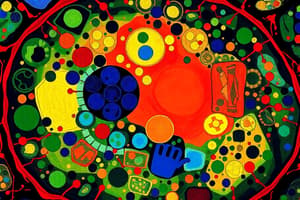Podcast
Questions and Answers
What is the main structural difference between prokaryotic and eukaryotic cells regarding their DNA?
What is the main structural difference between prokaryotic and eukaryotic cells regarding their DNA?
Prokaryotic cells have DNA that floats in the cytoplasm in a single loop called the nucleoid, while eukaryotic cells contain DNA within a membrane-bound nucleus.
Identify two types of microscopes used to study cell structure and their primary differences.
Identify two types of microscopes used to study cell structure and their primary differences.
Light microscopes magnify specimens using light and allow for live viewing, whereas electron microscopes use electron beams for much higher magnification and resolution but cannot view live specimens.
What are organelles, and how do they differ in prokaryotic and eukaryotic cells?
What are organelles, and how do they differ in prokaryotic and eukaryotic cells?
Organelles are specialized structures within a cell that perform specific functions; they have no membrane in prokaryotic cells, while in eukaryotic cells, organelles are membrane-bound.
Describe the average size and structure of prokaryotic cells.
Describe the average size and structure of prokaryotic cells.
What is the function of the nucleus in eukaryotic cells?
What is the function of the nucleus in eukaryotic cells?
How do transmission and scanning electron microscopes differ in their imaging methods?
How do transmission and scanning electron microscopes differ in their imaging methods?
What is the significance of the plasmid in prokaryotic cells?
What is the significance of the plasmid in prokaryotic cells?
Explain the total magnification calculation in microscopy.
Explain the total magnification calculation in microscopy.
What defines heterotrophs and what organisms fall under this category?
What defines heterotrophs and what organisms fall under this category?
How do chemotrophs obtain energy?
How do chemotrophs obtain energy?
What are the main functions of carbohydrates in living organisms?
What are the main functions of carbohydrates in living organisms?
What role do lipids play in biological systems?
What role do lipids play in biological systems?
What process converts glucose into ATP, and where does it occur in eukaryotic cells?
What process converts glucose into ATP, and where does it occur in eukaryotic cells?
What are the by-products of aerobic respiration?
What are the by-products of aerobic respiration?
Describe the light-dependent reactions of photosynthesis.
Describe the light-dependent reactions of photosynthesis.
What happens during the Krebs cycle?
What happens during the Krebs cycle?
What is the lock and key model in relation to enzyme activity?
What is the lock and key model in relation to enzyme activity?
How does temperature affect enzyme activity?
How does temperature affect enzyme activity?
What is denaturation in terms of enzyme structure?
What is denaturation in terms of enzyme structure?
Explain the significance of nucleic acids in cells.
Explain the significance of nucleic acids in cells.
What is anaerobic respiration and when does it occur?
What is anaerobic respiration and when does it occur?
What are two examples of organic compounds?
What are two examples of organic compounds?
What role does the nucleolus play in the cell?
What role does the nucleolus play in the cell?
How does the structure of the cell membrane contribute to its function?
How does the structure of the cell membrane contribute to its function?
What is the primary function of mitochondria in cells?
What is the primary function of mitochondria in cells?
What distinguishes the rough endoplasmic reticulum from the smooth endoplasmic reticulum?
What distinguishes the rough endoplasmic reticulum from the smooth endoplasmic reticulum?
Which type of transport requires energy and involves moving materials against their concentration gradient?
Which type of transport requires energy and involves moving materials against their concentration gradient?
Explain the process of osmosis.
Explain the process of osmosis.
What function do lysosomes serve in a cell?
What function do lysosomes serve in a cell?
Define facilitated diffusion.
Define facilitated diffusion.
What is the role of chloroplasts in plant cells?
What is the role of chloroplasts in plant cells?
How do channel proteins assist in the movement of substances across the cell membrane?
How do channel proteins assist in the movement of substances across the cell membrane?
What is the significance of the surface area to volume ratio for cellular efficiency?
What is the significance of the surface area to volume ratio for cellular efficiency?
What are autotrophs and how do they obtain energy?
What are autotrophs and how do they obtain energy?
Describe the process of endocytosis.
Describe the process of endocytosis.
Study Notes
Cell Types and Structure
- Prokaryotes: Single-celled organisms without a nucleus or membrane-bound organelles; examples include bacteria and archaea.
- Eukaryotes: Organisms with one or more cells that contain a membrane-bound nucleus and organelles; examples include animals, plants, fungi, and protists.
- Prokaryotic cells feature a cell membrane, cell wall, cytoplasm, ribosomes, and a nucleoid with a circular chromosome.
- Eukaryotic cells are larger and complex, ranging from 10-100 µm, and have more specialized structures.
Microscopy Technologies
- Light Microscopes: Magnification of up to 1000x, resolution greater than 200 nm, can view live specimens, generally more affordable.
- Electron Microscopes: Magnification up to 100,000x, resolution around 10 nm, only black & white images, cannot view live specimens, more expensive.
- Types of Electron Microscopes:
- Transmission Electron Microscopes (TEM): Produce high-definition 2D cross-sections by passing electrons through specimens.
- Scanning Electron Microscopes (SEM): Bounce electrons off specimen surfaces to show topography.
Organelles and Their Functions
- Nucleus: Controls cellular activities, contains DNA, involved in gene expression and replication.
- Nucleolus: Site of ribosome production.
- Cytoskeleton: Provides shape, structure, and facilitates movement of organelles.
- Ribosomes: Sites of protein synthesis, found in cytoplasm or attached to rough ER.
- Endoplasmic Reticulum (ER): Transport system; smooth ER synthesizes lipids and detoxifies chemicals, while rough ER is involved in protein synthesis.
- Golgi Apparatus: Modifies, stores, and packages proteins; vesicles transport molecules to and from it.
- Lysosomes: Contains digestive enzymes for waste breakdown (cell's garbage disposal).
- Mitochondria: Powerhouses that produce energy through cellular respiration; double-membrane bound.
- Chloroplasts: Site of photosynthesis in plant cells, containing chlorophyll (double-membrane bound).
- Cell Wall: Protective barrier found in plant and bacterial cells; located outside cell membrane.
- Cell Membrane: Semi-permeable membrane that controls substance passage in and out of the cell.
- Vacuoles: Store substances such as water, food, and wastes; larger in plant cells than in animal cells.
- Centrioles: Assist in cell division; found only in animal cells.
Membrane Structure: Fluid Mosaic Model
- Comprised of a phospholipid bilayer with embedded proteins and molecules.
- Semi-permeable, allowing selective passage of nutrients and waste.
- Phospholipids: Hydrophilic heads and hydrophobic tails create a barrier for certain molecules.
- Cholesterol stabilizes phospholipid arrangement, facilitating nonpolar molecule passage.
Transport Mechanisms
- Diffusion: Passive movement of molecules from high to low concentration.
- Osmosis: Movement of water across a semi-permeable membrane due to solute concentration gradients.
- Facilitated Diffusion: Utilizes channel or carrier proteins for passive molecular transport.
- Active Transport: Movement against concentration gradients requiring energy (ATP).
- Endocytosis: Engulfing of substances into the cell.
- Exocytosis: Expulsion of substances from the cell.
Surface Area to Volume Ratio
- Larger surface area to volume ratios promote efficient exchange of materials.
- Concentration gradients enhance diffusion efficiency.
- Material characteristics (size, polarity, and solubility) affect exchange rates.
Biochemical Compounds in Cells
- Key Elements: 96% of cell mass consists of carbon, hydrogen, oxygen, and nitrogen, essential for organic compounds.
- Autotrophs: Organisms that produce their own food using sunlight (e.g., plants).
- Heterotrophs: Organisms that cannot produce their own food (e.g., animals, fungi).
- Organic Compounds: Based on carbon structures, including carbohydrates, lipids, proteins, and nucleic acids.
- Inorganic Compounds: Water, salts, and carbon dioxide can either contain carbon or not.
Photosynthesis and Cellular Respiration
- Photosynthesis: Conversion of CO2 and water into glucose and oxygen using sunlight; occurs in chloroplasts with two stages - light-dependent and light-independent reactions.
- Cellular Respiration: Breakdown of glucose for ATP; occurs in mitochondria and can be aerobic (with oxygen) or anaerobic (without oxygen).
- Aerobic Respiration: Involves glycolysis, Krebs cycle, and electron transport chain; produces 36 ATP from one glucose.
- Anaerobic Respiration: Produces only 2 ATP from glucose; common in yeast.
Enzyme Action and Factors Affecting Activity
- Enzymes: Proteins that act as catalysts to speed up reactions, specific to substrates.
- Lock and Key Model: Enzyme active sites exactly fit specific substrates.
- Factors Influencing Enzyme Activity:
- Temperature: Optimal at 37°C; temperatures too high cause denaturation.
- pH: Enzymes have optimal pH ranges; deviation slows reaction rates.
- Substrate Concentration: Higher amounts increase reaction rates until saturation is reached.
Studying That Suits You
Use AI to generate personalized quizzes and flashcards to suit your learning preferences.
Description
Test your knowledge on cell types, including prokaryotes and eukaryotes, as well as the microscopy technologies used to study them. This quiz covers the fundamental structures of cells and the differences between light and electron microscopes.



